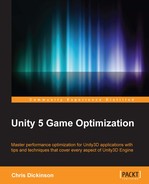We have already covered some techniques on mesh optimization in Chapter 4, Kickstart Your Art, which can help reduce our mesh's vertex attributes. As a quick reminder, it is not uncommon to use a mesh that contains a lot of unnecessary UV and Normal vector data, so our meshes should be double-checked for this kind of superfluous fluff. We should also let Unity optimize the structure for us, which minimizes cache misses as vertex data is read within the front end.
We will also learn some useful Shader optimization techniques shortly, when we begin to discuss back end optimizations, since many optimization techniques apply to both Fragment and Vertex Shaders.
The only attack vector left to cover is finding ways to reduce actual vertex counts. The obvious solutions are simplification and culling; either have the art team replace problematic meshes with lower polycount versions, and/or remove some objects from the scene to reduce the overall polygon count. If these approaches have already been explored, then the last approach we can take is to find some kind of middle ground between the two.
Since it can be difficult to tell the difference between a high quality distance object and a low quality one, there is very little reason to render the high quality version. So, why not dynamically replace distant objects with something more simplified?
Level Of Detail (LOD), is a broad term referring to the dynamic replacement of features based on their distance or form factor relative to the camera. The most common implementation is mesh-based LOD: dynamically replacing a mesh with lower and lower detailed versions as the camera gets farther and farther away. Another example might be replacing animated characters with versions featuring fewer bones, or less sampling for distant objects, in order to reduce animation workload.
Making use of LOD can be achieved by placing multiple objects in the Scene and making them children of a GameObject with an attached LODGroup component. The LODGroup's purpose is to generate a bounding box from these objects, and decide which object should be rendered based on the size of the bounding box within the camera's field of view. If the object's bounding box consumes a large area of the current view, then it will enable the mesh(es) assigned to lower LOD groups, and if the bounding box is very small, it will replace the mesh(es) with those from higher LOD groups. If the mesh is too far away, it can be configured to hide all child objects. So, with the proper setup, we can have Unity replace meshes with simpler alternatives, or cull them entirely, which eases the burden on the rendering process.
Note
Check the Unity documentation for more detailed information on the LOD feature: http://docs.unity3d.com/Manual/LevelOfDetail.html.
This feature can cost us a large amount of development time to fully implement; artists must generate lower polygon count versions of the same object, and level designers must generate LOD groups, configure them, and test them to ensure they don't cause jarring transitions as the camera moves closer or farther away. It also costs us in memory and runtime CPU; the alternative meshes need to be kept in memory, and the LODGroup component must routinely test whether the camera has moved to a new position that warrants a change in LOD level.
In this era of graphics card capabilities, vertex processing is often the least of our concerns. Combined with the additional sacrifices needed for LOD to function, developers should avoid preoptimizing by automatically assuming LOD will help them. Excessive use of the feature will lead to burdening other parts of our application's performance, and chew up precious development time, all for the sake of paranoia. If it hasn't been proven to be a problem, then it's probably not a problem!
Scenes that feature large, expansive views of the world, and lots of camera movement, should consider implementing this technique very early, as the added distance and massive number of visible objects will exacerbate the vertex count enormously. Scenes that are always indoors, or feature a camera with a viewpoint looking down at the world (real-time strategy and MOBA games, for example) should probably steer clear of implementing LOD from the beginning. Games somewhere between the two should avoid it until necessary. It all depends on how many vertices are expected to be visible at any given time and how much variability in camera distance there will be.
As previously mentioned, we could enable GPU Skinning to reduce the burden on a CPU-bound application, but enabling this feature will push the same workload into the front end of the GPU. Since Skinning is one of those "embarrassingly parallel" processes that fits well with the GPU's parallel architecture, it is often a good idea to perform the task on the GPU. But this task can chew up precious time in the front end preparing the vertices for fragment generation, so disabling it is another option we can explore if we're bottlenecked in this area. Again, this feature can be toggled under Edit | Project Settings | Player Settings | Other Settings | GPU Skinning.
There is one last task that takes place in the front end process and that we need to consider: tessellation. Tessellation through Geometry Shaders can be a lot of fun, as it is a relatively underused technique that can really make our graphical effects stand out from the crowd of games that only use the most common effects. But, it can contribute enormously to the amount of processing work taking place in the front end.
There are no simple tricks we can exploit to improve tessellation, besides improving our tessellation algorithms, or easing the burden caused by other front end tasks to give our tessellation tasks more room to breathe. Either way, if we have a bottleneck in the front end and are making use of tessellation techniques, we should double-check that they are not consuming the lion's share of the front end's budget.
